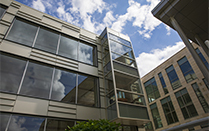
IMPROVING CAMPUS INFRASTRUCTURE
Some of the major improvements to infrastructure completed over the summer are very visible; others are not. Read in this issue about the many major projects completed by Physical Facilities and Information Technology Services, as well as the new programs offered by the University Center for Training and Development.

SCHOOL OF PHARMACY AND PHARMACEUTICAL SCIENCES OPENS NEW BUILDING
The opening of the new, $60-million School of Pharmacy and Pharmaceutical Sciences at the University's Health Sciences Campus in Johnson City, N.Y., headlines this quarterly report, but there's also good news about collaborations, external funding and student successes. Read more in this issue.
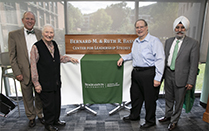
SUCCESSFUL INITIATIVES SUPPORT STUDENTS
It takes donors at many levels to make Binghamton University successful, and in this issue of the quarterly report, you can read about a number of them. Whether it's AVANGRID offering full-tuition scholarships and capstone project support, or playing golf to benefit the Alumni Legacy Scholarship, the Division of Advancement works with Binghamton supporters.
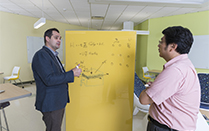
BINGHAMTON RESEARCH FUNDING SETS RECORD
Binghamton University reported research expenditures totaling $47.5 million in 2017-18, an increase of about 19 percent from the previous fiscal year. The figure tops 2011-12, the campus’ all-time best year for research funding, when just over $40 million was reported. The new record, which follows several years of steady growth, is an important sign of the campus’ creativity and innovation. Healthcare research accounted for nearly a third of expenditures, with electronics packaging and systems engineering following at about 22 percent.

BAXTER THE BEARCAT BOOSTS SCHOOL SPIRIT
The Division of Student Affairs spent the summer hosting students and families for orientation and preparing for the opening of the fall semester. With some new people on board and some others with new duties, it has been a busy time. Not too busy, though, to show Binghamton University pride, as you'll read about the new Baxter the Bearcat Bench in the University Union in this issue.
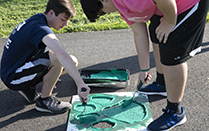
STUDENT-ATHLETES CONTINUE TO SUCCEED ACADEMICALLY
Student-athletes continue to shine on and off the courts and fields. The Athletics Department sets high academic standards, and student-athletes surpass them across the board. Read about the accomplishments made by student-athletes in their sports and in the classroom – and check out the videos showcasing fall sports and the new women's head basketball coach, Bethann Shapiro Ord, in this issue.
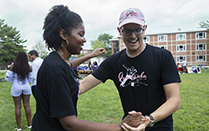
HELPING TO MAKE THE CAMPUS MORE INCLUSIVE
The Division of Diversity, Equity and Inclusion works to educate and empower everyone on campus in ways that create a welcoming community. From the Udiversity Educational Institute, that holds trainings for students, faculty and staff, to the Multicultural Resource Center and Q Center, the division's offices that work to build bridges and support students though education and events such as Sundaze, part of its Welcome Week programming. Read about the division's recent initiatives in this report.
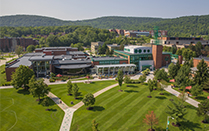
DONOR SUPPORT ADVANCES BINGHAMTON UNIVERSITY
The Binghamton University Foundation had a successful 2017-18 year, bringing in the second highest amount of cash ever in support of the University. Read the numbers in this issue of the quarterly report, and learn one way the Foundation celebrates its donors.
Ancient forest may offer climate-change insights
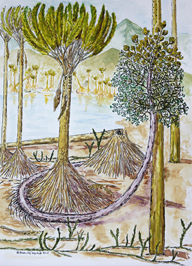
A Binghamton University scientist and his colleagues reported the discovery of the floor of the world’s oldest forest earlier this year in the journal Nature.
“It was like discovering the botanical equivalent of dinosaur footprints,” said William Stein, associate professor of biological sciences, and one of the article’s authors. “But the most exciting part was finding out just how many different types of footprints there were. The newly uncovered area was preserved in such a way that we were literally able to walk among the trees, noting what kind they were, where they had stood and how big they had grown.”
The town of Gilboa in upstate New York is famous as home of some of the earliest tree fossils. But after a new round of excavation, scientists may gain new insight into the role of modern-day forests and their impact on climate change.
The Gilboa area has been known as a tree fossil location since the late 1800s. During the 1920s, when construction of the Schoharie Dam revealed a dense stand of trees, paleontologists began to investigate the site in earnest. Named Eospermatopteris, or “ancient seed fern,” by Winifred Goldring of the New York State Museum in 1924, these earliest trees had survived only as broken standing bases and trunks. More detailed glimpses of the past emerged in 2004 and 2005, when specimens with crowns were discovered.
The research team caught a break in 2010, when repairs on the Gilboa Dam reopened the site. What they found was a substantially intact portion of the ancient forest horizon, complete with root systems.
When the Gilboa forest began to emerge — about 386 million years ago — Earth experienced a dramatic drop in global atmospheric carbon dioxide levels and the associated cooling led to a period of glaciation.
“Trees probably changed everything,” Stein said. “Not only did these emerging forests likely cause important changes in global patterns of sedimentation, but they may have triggered a major extinction in fossil records.”
Stein describes what today’s scientists learn from the world’s oldest forest in this brief video: